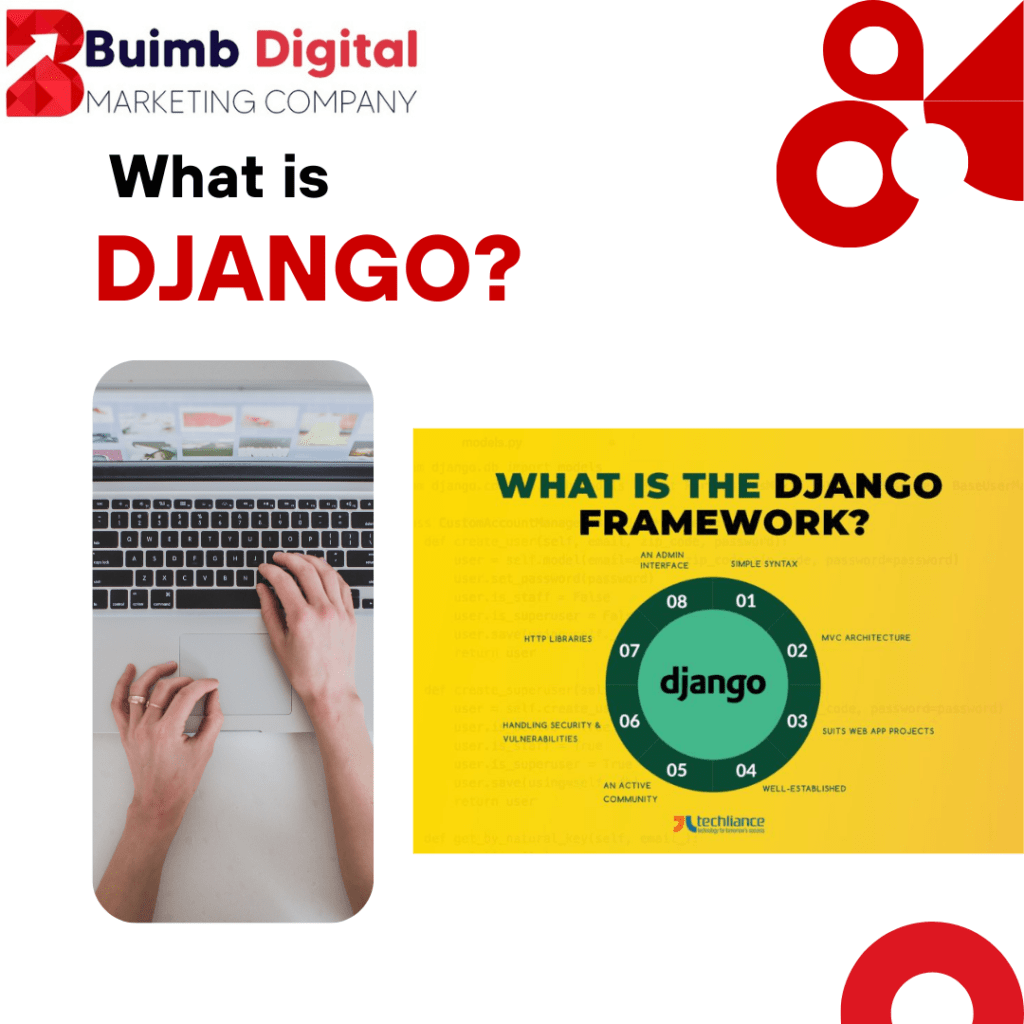What is Django?
Understanding Django
Django is a high-level Python web framework that encourages rapid development and clean, pragmatic design. It follows the “Don’t Repeat Yourself” (DRY) principle and emphasizes reusability, allowing developers to build web applications quickly by focusing on writing code that matters

History of Django
Django was created in 2003 by Adrian Holovaty and Simon Willison while working at the Lawrence Journal-World newspaper. They aimed to build a framework that would enable developers to create web applications with ease and maintainability. Django was released as an open-source project in 2005 under the BSD license, leading to its widespread adoption and continuous development by a vibrant community of contributors.
Core Features of Django
- MTV Architecture: Django adopts the Model-Template-View (MTV) architecture, which is similar to the Model-View-Controller (MVC) pattern but with slight differences. In Django:
- Model: Defines the data structure (typically using Django’s ORM).
- Template: Handles presentation logic (HTML files with Django template language).
- View: Processes user requests and returns responses (Python functions).
- ORM (Object-Relational Mapping): Django provides a powerful ORM that abstracts database access and simplifies data manipulation using Python objects. Developers interact with databases through models, allowing seamless integration and portability across different database engines (e.g., PostgreSQL, MySQL, SQLite).
- Admin Interface: Django includes a built-in admin interface that automatically generates CRUD (Create, Read, Update, Delete) interfaces for models. This feature accelerates development by providing an out-of-the-box solution for managing application data.
- URL Routing: Django uses a URL routing mechanism that maps URL patterns to views, enabling clean and organized URL structures. URLs are defined in a centralized manner, promoting maintainability and readability.
- Forms Handling: Django simplifies form creation, validation, and processing. It provides built-in form classes and validation mechanisms, reducing boilerplate code and ensuring data integrity.
- Security: Django has built-in security features such as protection against common web vulnerabilities (CSRF, XSS, SQL injection), user authentication, authorization mechanisms, and secure password hashing.
- Template Engine: Django’s template engine allows developers to build dynamic HTML templates with minimal syntax. Templates support template inheritance, context variables, filters, and tags, facilitating code reuse and separation of concerns.
Django’s Ecosystem
Beyond its core features, Django boasts a rich ecosystem of libraries, packages, and extensions that enhance its functionality and cater to diverse application requirements:
- Django REST framework: A powerful toolkit for building Web APIs in Django, providing serialization, authentication, and customizable views.
- Django Channels: Enables handling of WebSockets and asynchronous communication in Django applications, facilitating real-time features like chat and notifications.
- Celery: Integrates asynchronous task queueing into Django applications, allowing background task execution (e.g., sending emails, processing data).
- Third-Party Packages: Django community contributes numerous packages for functionalities such as social authentication, geolocation services, payment gateways, and more.
Why Choose Django?
- Rapid Development: Django’s “batteries-included” philosophy and built-in features enable rapid prototyping and development of web applications.
- Scalability: Django’s design principles promote maintainability and scalability, making it suitable for projects of varying sizes and complexities.
- Community and Support: Django has a thriving community of developers, extensive documentation, and active support channels, ensuring assistance and resources are readily available.
- Versatility: Django’s flexibility allows it to be used for a wide range of applications, from content management systems (e.g., Django CMS) to e-commerce platforms (e.g., Saleor) and beyond.
Case Studies and Applications
Numerous high-profile websites and applications have been built using Django, underscoring its capability and reliability:
- Instagram: Initially built with Django, Instagram leverages its scalability and efficiency to handle massive user interactions and data management.
- Pinterest: Uses Django for its backend infrastructure, benefiting from its robustness in handling content management and user interactions.
- The Washington Post: Employs Django for its content management and publishing platform, showcasing Django’s suitability for media and publishing industries.
Future Trends and Considerations
Looking ahead, Django continues to evolve to meet the demands of modern web development:
- Integration with AI and Machine Learning: Django applications are increasingly incorporating AI and ML capabilities through libraries like TensorFlow and scikit-learn.
- Microservices Architecture: Django can be used in microservices architectures, leveraging its modular design and RESTful API capabilities.
- Serverless Computing: Django applications can benefit from serverless platforms (e.g., AWS Lambda) for cost efficiency and scalability.
Conclusion
In conclusion, Django stands as a cornerstone in the world of web development, renowned for its simplicity, scalability, and extensive feature set. Whether you’re a seasoned developer or a newcomer to web development, Django offers a robust framework for creating sophisticated web applications with ease. Its vibrant community, comprehensive documentation, and ecosystem of libraries ensure that developers can continually innovate and build upon its foundations.
As we navigate the ever-evolving landscape of technology, Django remains a steadfast ally, empowering developers to turn ideas into reality and shape the future of web applications. By embracing Django’s philosophy of pragmatism and efficiency, developers can forge ahead, leveraging its capabilities to build scalable, secure, and impactful web solutions for the digital age.



